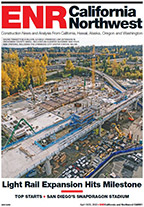New York Construction: Why do you think you won � why did the industry chose you as owner of the year?

MUELLER
Jim Mueller: I think it’s a combination of volume of work, but also a function of us trying to improve the way we do business in terms of managing contracts and streamlining our business processes in an effort to make the DEP a better client. I wouldn’t say we’re done, but I think we can say that we’re done starting the process. It’s kind of the end of the beginning. Our engagement of staff both here and with our 300-plus engineers who are out there designing and managing the work, I think people in the construction industry are beginning to see that manifest itself in terms of progress on jobs, problems getting knocked down and schedules starting to move. Like I said, I don’t think we’re done by a long shot, but I think it’s that combination of getting the work out there steadily and trying to constantly improve the way we manage it.
Bernard Daly: I think we’re also one of the safer owners out there.

MALLON

BORSYKOWSKY
Michael Borsykowsky: Definitely. It’s our highest priority. Our program has matured quite a bit in that regard. We’ve staffed up to a high level of competency within the agency. We’re also doing a much better job of auditing our sites so people know that we have active site representatives from the contractors that are ensuring that work is done with the written health and safety plans. We also have our own in-house people and third party people so we can send down and audit the sites. That’s had a real significant impact. Our numbers are very good. I think we still have some areas that could use improvement but considering the amount of manpower we have out there now and heavy equipment we have in play our safety performance has been very successful.
BD: We have requirements in the contracts that the firms have to have a site safety professional on site. Then we require the CM have its own safety staff. So we really have a very robust safety program in place.
MB: And it’s very important that we do. We have, what, 17, 18 cranes in place at Croton alone? [Safety] has to be a big part of our focus.
JM: I think it’s also been important for us to work on forging good relationships with other agencies – I’m talking about departments like the fire department or the Department of Buildings or ConEd. We’ve made a concerted effort at all levels – from our safety program to our construction program to our design program – to make sure we’re coordinating all that very well with our oversight and I think it’s really paying off in terms of streamlining projects and solving issues instead of having them linger or having fingers being pointed.
NYC: You mentioned the volume of work you have in the ground right now. Has this agency ever seen anything like this?
Commissioner Caswell Holloway: We’re in a period of unprecedented construction at the DEP, by any measure. Whether you’re talking the number of projects, the size of projects, the amount of committed capital dollars, the number of construction workers, the burn rate we’re going through on a daily basis – you name it – there’s a considerable amount of work that we’re managing right now. I don’t think people understand the magnitude all of this work carries in terms of the changes to the water system in the city that are going to carry us through the next hundred or so years. So getting these investments finished and getting them turned on in huge. Four years in the life of DEP is the blink of an eye. The legacy is going to be that the system is going to be transformed in a way not seen probably since the initial development that brought the watershed water to the city.
MB: We’ve got these megaprojects going and some of them are the manifestation of planning that has been going on for decades. City Tunnel 3 has been going on for many, many years; Croton has been in the ground a long time. There is a tremendous amount of planning has preceded us and enabled us to facilitate putting in the phases that we’re involved with and we’re also looking ahead with an eye toward the phases that will come after us. Hopefully we’ll be able to be appreciated for our foresight the same way we appreciated our predecessors from the Board of Water Supply or on the wastewater side. We are in a bubble of tremendous work right now where between Newtown Creek, City Tunnel 3, Ultraviolet Disinfection and Croton, this is really a tremendous program for us. The budget is going to be a little tighter coming up and we’re going to need to work even harder to make sure every dollar we spend is absolutely prioritized and prioritized again. We’re going to have to look to defer some projects that we’d like to do in order to focus on some projects that we absolutely must put out.
JM: And, you know, it’s been about 50 years since they finished building out the Delaware (water) system. That was back in the 1960s and that was a tremendous amount of work. So what we’re doing right now is a one-in-fifty- or one-in-a-hundred-year kind of era for us. And then we’re pushing our last Clean Water Act project (Greenpoint’s Newtown Creek) at the same time. If you go back far enough, back around World War I and World War II the agency was building the aqueducts and those were pretty significant projects to be working on in what was relatively the same era. But in recent times, this is by far the biggest we’ve been.
NYC: With so many firms hurting as work has dried up, and with the DEP having put out so much work, are you seeing a difference in terms of the bids you’re getting?














Post a comment to this article
Report Abusive Comment